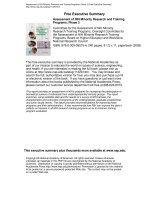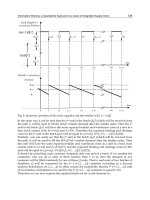Research and Markets Project Management_8 ppt
Bạn đang xem bản rút gọn của tài liệu. Xem và tải ngay bản đầy đủ của tài liệu tại đây (301.25 KB, 27 trang )
260 REPORTING RESULTS
when they were collected, who provided them, how the effect of the project
was isolated from other influences, and how data were converted to mon-
etary values. The various assumptions, adjustments, and conservative
approaches are presented along with the total cost of the project, so
that the target audience will begin to buy into the process of developing
the ROI.
When the data are actually presented, the results are given one level at
a time, starting with Level 1, moving through Level 5, and ending with the
intangibles. This allows the audience to observe the reaction, learning,
application and implementation, business impact, and ROI procedures.
After some discussion of the meaning of the ROI, the intangible measures
are presented. Allocate time for each level as appropriate for the audience.
This helps to defuse potential emotional reactions to a very positive or
negative ROI.
Show the consequences of additional accuracy if this is an issue. The
trade-off for more accuracy and validity often is more expense. Address
this issue when necessary, agreeing to add more data if they are required.
Collect concerns, reactions, and issues involving the process and make
adjustments accordingly for the next presentation.
Collectively, these steps will help in the preparation and presentation
of one of the most important meetings in the ROI process. Figure 13.1
Presentation Sequence
Describe the program and explain why it is being evaluated
Present the methodology process.
Present the reaction and learning data.
Present the application data.
List the barriers and enablers to success.
Address the business impact.
Show the costs.
Present the ROI.
Show the intangibles.
Review the credibility of the data.
Summarize the conclusions.
Present the recommendations.
1.
2.
3.
4.
5.
6.
7.
8.
9.
10.
11.
12.
Purpose of the Meeting
• Create awareness and understanding
of ROI.
• Build support for the ROI methodology.
• Communicate results of study
• Drive improvement from results.
• Cultivate effective use of the ROI
methodology.
Meeting Ground Rules
• Do not distribute the impact study until
the end of the meeting
• Be precise and to the point.
• Avoid jargon and unfamiliar terms.
• Spend less time on the lower levels of
evaluation data.
• Present the data with a strategy in mind.
Figure 13.1 Presenting the impact study to executive sponsors.
Final Thoughts 261
shows the recommended approach to an important meeting with the
sponsor.
REACTIONS TO COMMUNICATION
The best indicator of how effectively the results of a project have been
communicated is the level of commitment and support from the managers,
executives, and sponsors. The allocation of requested resources and voiced
commitment from top management are strong evidence of management’s
positive perception of the results. In addition to this macro-level reaction,
a few techniques can also be helpful in measuring the effectiveness of the
communication effort.
When results are communicated, the reactions of the target audi-
ences can be monitored. These reactions may include nonverbal gestures,
oral remarks, written comments, or indirect actions that reveal how the
communication was received. Usually, when results are presented in
a meeting, the presenter will have some indication of how they were
received by the group. Usually, the interest and attitudes of the audi-
ence can be quickly evaluated. Comments about the results—formal or
informal—should be noted and tabulated.
Project team meetings are an excellent arena for discussing the reac-
tion to communicated results. Comments can come from many sources
depending on the particular target audience. When major project results
are communicated, a feedback questionnaire may be administered to the
entire audience or a sample of the audience. The purpose of the ques-
tionnaire is to determine the extent to which the audience understood
and/or believed the information presented. This is practical only when
the effectiveness of the communication will have a significant impact on
future actions by the project team.
FINAL THOUGHTS
The final step in the ROI methodology, communication of results, is a
crucial step in the overall evaluation process. If this step is not executed
adequately, the full impact of the results will not be recognized, and the
study may amount to a waste of time. The chapter began with general
principles and steps for communicating project results; these can serve
as a guide for any significant communication effort. The various target
audiences were then discussed, with emphasis on the executive group
because of its importance. A suggested format for a detailed evaluation
262 REPORTING RESULTS
report was also provided. The chapter presented the most commonly
used media for communicating project results, including meetings, client
publications, and electronic media.
A final issue regarding the ROI methodology will be discussed in
the next chapter: overcoming barriers to sustaining the use of the
methodology.
Chapter 14
Implementing and Sustaining ROI
Even the best-designed process, model, or technique is worthless unless
it is effectively and efficiently integrated into the organization. Often,
resistance to the ROI process arises. Some of this resistance is based
on fear and misunderstanding. Some is real, based on actual barriers
and obstacles. Although the ROI process presented in this book is a
step-by-step, methodical, and simplistic procedure, it can fail if it is not
integrated properly, fully accepted, and supported by those who must
make it work within the organization. This chapter focuses on some of
the most effective means of overcoming resistance to implementing the
ROI process in an organization.
THEIMPORTANCEOFSUSTAININGTHEUSEOFROI
With any new process or change, there is resistance. Resistance may be
especially great when implementing a process as c omplex as ROI. To
implement ROI and sustain it as an important accountability tool, the
resistance must be minimized or r em oved. Successful implementation
essentially equates to overcoming resistance. Explained below are four
key reasons to have a detailed plan in place to overcome resistance.
Resistance Is Always Present
Resistance to change is a constant. Sometimes, there are good reasons for
resistance, but often it exists for the wrong reasons. The important point
is to sort out both kinds of resistance and try to dispel the myths. When
263
Project Management ROI: A Step-by-Step Guide for Measuring the Impact and ROI for Projects
Jack J. Phillips, Wayne Brantley, and Patricia Pulliam Phillips
Copyright © 2012 John Wiley & Sons, Inc.
264 IMPLEMENTING AND SUSTAINING ROI
legitimate barriers are the basis for resistance, minimizing or removing
them altogether is the challenge.
Implementation Is Key
As with any process, effective implementation is the key to its success.
This occurs when the new technique, tool, or process is integrated into
the routine framework. Without effective implementation, even the best
process will fail. A process that is never removed from the shelf will
never be understood, supported, or improved. Clear-cut steps must be
in place for designing a comprehensive implementation process that will
overcome resistance.
Consistency Is Needed
Consistency is an important consideration as the ROI process is imple-
mented. With consistency come accuracy and reliability. The only way to
make sure consistency is achieved is to follow clearly defined processes
and procedures each time the ROI methodology is used. Proper effective
implementation will ensure that this occurs.
Efficiency
Cost control and efficiency will be significant considerations in any major
undertaking, and the ROI methodology is no exception. During imple-
mentation, tasks must be completed efficiently and effectively. Doing so
will help ensure that process costs are kept to a minimum, that time is
used economically, and that the process remains affordable.
IMPLEMENTING THE PROCESS: OVERCOMING
RESISTANCE
Resistance shows up in varied ways: in the form of comments, remarks,
actions, or behaviors. Table 14.1 lists representative comments that
indicate open resistance to the ROI process. Each comment signals an
issue that must be resolved or addressed in some way. A few are based
on realistic barriers, whereas others are based on myths that must
be dispelled. Sometimes, resistance to the process reflects underlying
concerns. For example, the project managers involved may fear losing
Implementing the Process: Overcoming Resistance 265
Table 14.1 Typical Objections to the Use of ROI Methodology
Open Resistance
1. It costs too much.
2. It takes too much time.
3. Who is asking for this?
4. This is not in my job description.
5. I did not have input on this.
6. I do not understand this.
7. What happens when the results are negative?
8. How can we be consistent with this?
9. The ROI looks too subjective.
10. Our managers will not support this.
11. ROI is too narrowly focused.
12. This is not practical.
control of their processes, and others may feel vulnerable to whatever
action may follow if the project is not successful. Still others may be
concerned about any process that brings change or requires the additional
effort of learning.
Project managers and team members may resist the ROI process and
openly make comments similar to those listed in Table 14.1. It may
take heavy persuasion and evidence of tangible benefits to convince team
members that it is in their best interest to make the project a success.
Although most clients do want to see the results of the project, they may
have concerns about the information they are asked to provide and about
whether their personal performance is being judged while the project
is undergoing evaluation. Participants may express the very same fears
listed in the table.
The challenge is to implement the methodology systematically and
consistently so that it becomes normal business behavior and a routine
and standard process built into projects. The implementation necessary
to overcome resistance covers a variety of areas. Figure 14.1 shows
actions outlined in this chapter that are presented as building blocks to
overcoming resistance. They are all necessary to build the proper base
or framework to dispel myths and remove or minimize barriers. The
remainder of this chapter presents specific strategies and techniques
devoted to each building block identified in Figure 14.1. They apply
266 IMPLEMENTING AND SUSTAINING ROI
Initiating ROI projects
Preparing clients and executives
Removing obstacles
Monitoring progress
Preparing project team
Revising policies and procedures
Establishing goals and plans
Developing roles and responsibilities
Assessing climate for measuring ROI
Figure 14.1 Building blocks to overcome resistance.
equally to the project team and the client organization, and no attempt
is made to separate the two in this presentation. In some situations, a
particular strategy would work best with the project team. In certain
cases all strategies may be appropriate for both groups.
ASSESSING THE CLIMATE
As a first step toward implementation, some organizations assess the
current climate for achieving results. One way to do this is to develop
a survey to determine current perspectives of the project management
team and other stakeholders (for an example go to www.roiinstitute.net).
Another way is to conduct interviews with key stakeholders to determine
their willingness to follow the project through to ROI. With an awareness
of the current status, the project leaders can plan for significant changes
and pinpoint particular issues that need support as the ROI process is
implemented.
DEVELOPING ROLES AND RESPONSIBILITIES
Defining and detailing specific roles and responsibilities for different
groups and individuals addresses many of the resistance factors and
helps pave a smooth path for implementation.
Developing Roles and Responsibilities 267
Identifying a Champion
As an early step in the process, one or more individual(s) should be
designated as the internal leader or champion for the ROI methodology.
As in most change efforts, someone must take responsibility for ensuring
that the process is implemented successfully. This leader serves as a
champion for ROI and is usually the one who understands the process
best and sees vast potential for its contribution. More important, this
leader is willing to teach others and will work to sustain sponsorship.
Developing the ROI Leader
The ROI leader is usually a member of the project team who has the
responsibility for evaluation. For large organizations, the ROI leader
may be part of the support services for project management. This person
holds a full-time position in larger project teams or a part-time position
in smaller teams. Client organizations may also have an ROI leader who
pursues the ROI methodology from the client’s perspective. The typical
job title for a full-time ROI leader is Manager of Measurement and
Evaluation. Some organizations assign this responsibility to a team and
empower it to lead the ROI effort.
In preparation for this assignment, individuals usually receive special
training that builds specific skills and knowledge of the ROI process. The
role of the implementation leader is quite broad and serves a variety
of specialized duties. In some organizations, t he implementation leader
can take on many roles, ranging from problem solver to communicator to
cheerleader.
Leading the ROI process is a difficult and challenging assignment
that requires unique skill. Fortunately, programs are available that
teach these skills. For example, one such program is designed to certify
individuals who will be assuming leadership roles in the implementation
of the ROI methodology. For more detail, see www.roiinstitute.net. This
certification is built around ten specific skill sets linked to successful
ROI implementation, focusing on the critical areas of data collection,
isolating the effects of the project, converting data to monetary value,
presenting evaluation data, and building capability. This process is quite
comprehensive but may be necessary to build the skills necessary for
taking on this challenging assignment.
268 IMPLEMENTING AND SUSTAINING ROI
Establishing a Task Force
Making the ROI methodology work well may require the use of a task
force. A task force usually comprises a group of individuals from different
parts of the project or client team who are willing to develop the ROI
methodology and implement it in the organization. The selection of the
task force may involve volunteers, or participation may be mandatory
depending on specific job responsibilities. The task force should represent
the cross section necessary for accomplishing stated goals. Task forces
have the additional advantage of bringing more people into the process
and developing more ownership of and support for the ROI methodology.
The task force must be large enough to cover the key areas but not so
large that it becomes too cumbersome to function. Six to twelve members
is a good size.
Assigning Responsibilities
Determining specific responsibilities is critical because confusion can
arise when individuals are unclear about their specific assignments
in the ROI process. Responsibilities apply to two areas. The first is
the measurement and evaluation responsibility o f the entire project
team. Everyone involved in projects must have some responsibility for
measurement and evaluation. These responsibilities include providing
input on designing instruments, planning specific evaluations, analyzing
data, and interpreting the results. Typical responsibilities include:
•
Ensuring that the initial analysis for the project includes specific
business impact measures
•
Developing specific application and business impact objectives for
the project
•
Keeping participants focused on application and impact objectives
•
Communicating rationale and reasons for evaluation
•
Assisting in follow-up activities to capture application and business
impact data
•
Providing assistance for data collection, data analysis, and reporting
Although involving each member of the project team in all these
activities may not be appropriate, each individual should have at least
one responsibility as part of his or her routine job duties. This assignment
of responsibility keeps the ROI methodology from being disjointed and
Establishing Goals and Plans 269
separated during projects. More important, it brings accountability to
those directly involved in project implementation.
Another issue involves technical support. Depending on the size of the
project team, establishing a group of technical experts to provide assis-
tance with the ROI process may be helpful. Once the group is established,
the project team must understand that the experts have been assigned
not for the purpose of relieving the team of its evaluation responsibil-
ities, but to supplement its ROI efforts with technical expertise. These
technical experts are typically the individuals who participated in the
certification and training process to build special skills. Responsibilities
of the technical support group involve six key areas:
1. Designing data collection instruments
2. Providing assistance for developing an evaluation strategy
3. Analyzing data, including specialized statistical analyses
4. Interpreting results and making specific recommendations
5. Developing an evaluation report or case study to communicate
overall results
6. Providing technical support in all phases of the ROI methodology
The assignment of responsibilities for evaluation requires attention
throughout the evaluation process. Although the project team must be
assigned specific responsibilities during an evaluation, requiring others
to serve in support functions to help with data collection is not unusual.
These responsibilities are defined when a particular evaluation strategy
plan is developed and approved.
ESTABLISHING GOALS AND PLANS
Establishing goals, targets, and objectives is critical to the implementa-
tion, particularly when several projects are planned. The establishment
of goals can include detailed planning documents for the overall process
and for individual ROI projects. The next sections discuss aspects of the
establishment of goals and plans.
Setting Evaluation Targets
Establishing specific targets for evaluation levels is an important way
to make progress with measurement and evaluation. As emphasized
270 IMPLEMENTING AND SUSTAINING ROI
Table 14.2 Evaluation Targets in a Large Organization
with Many Projects
Level Target
Level 1, Reaction 100%
Level 2, Learning 80%
Level 3, Application and Implementation 40%
Level 4, Business Impact 25%
Level 5, ROI 10%
throughout this book, not every project should be evaluated to ROI.
Knowing in advance to which level the project will be evaluated helps in
planning which measures will be needed and how detailed the evaluation
must be at each level. Table 14.2 presents examples of targets set for
evaluation at each level. The setting of targets should be completed
early in the process with the full support of the entire project team. If
practical and feasible, the targets should also have the approval of key
managers—particularly the senior management team.
Developing a Plan for Implementation
An important part of implementation is establishing a timetable for the
complete implementation of the ROI process. This document becomes a
master plan for completion of the different elements presented earlier.
Beginning with forming a team and concluding with meeting the targets
previously described, this schedule is a project plan for transitioning
from the present situation to the desired future situation. Items on the
schedule include developing specific ROI projects, building staff skills,
developing policy, and teaching managers the process. Figure 14.2 is an
example of an implementation plan. The more detailed the document, the
more useful it becomes. The project plan is a living, long-range document
that should be reviewed frequently and adjusted as necessary. More
important, those engaged in work on the ROI methodology should always
be familiar with the implementation plan.
REVISING OR DEVELOPING POLICIES AND GUIDELINES
Another part of planning is revising or developing the organization’s
policy on project measurement and evaluation. The policy statement
contains information developed specifically for the measurement and
Revising or Developing Policies and Guidelines 271
J FMAM J J AS SOONNDJFMA AMJ J
Team formed
Responsibilities defined
Policy developed
Targets set
Workshops developed
ROI Project (A)
ROI Project (B)
ROI Project (C)
ROI Project (D)
Project teams trained
Managers trained
Support tools developed
Guidelines developed
Figure 14.2 Implementation plan for a large organization with many projects.
evaluation process. It is developed with input from the project team and
key managers or stakeholders. Sometimes, policy issues are addressed
during internal workshops designed to build measurement and evaluation
skills. The policy statement addresses critical matters that will influence
the effectiveness of the measurement and evaluation process. These
may include adopting the five-level framework presented in this book,
requiring Level 3 and 4 o bjectives for some or all projects, and defining
responsibilities for the project team.
Policy statements are important because they provide guidance and
direction for the staff and others who work closely with the ROI method-
ology. These individuals keep the process clearly focused, and enable the
group to establish goals for evaluation. Policy statements also provide
an opportunity to communicate basic requirements and fundamentals of
performance and accountability. More than anything else, they serve as
learning tools to teach others, especially when they are developed in a
collaborative way. If policy statements are developed in isolation, staff
and management will be denied the sense of their ownership, making
them neither effective nor useful.
272 IMPLEMENTING AND SUSTAINING ROI
Guidelines for measurement and evaluation are important for showing
how to use the tools and techniques, guide the design process, provide
consistency in the ROI process, ensure that appropriate methods are
used, and place the proper emphasis on each of the areas. The guidelines
are more technical than policy statements and often include detailed
procedures showing how the process is undertaken and developed. They
often include specific forms, instruments, and tools necessary to facilitate
the process.
PREPARING THE PROJECT TEAM
Project team members may resist the ROI methodology. They often see
evaluation as an unnecessary intrusion into their responsibilities that
absorbs precious time and stifles creative freedom. The cartoon character
Pogo perhaps characterized it best when he said, ‘‘We have met the
enemy, and he is us.’’ Several issues must be addressed when preparing
the project team for ROI implementation.
Involving the Project Team
For each key issue or major decision involving ROI implementation, the
project team should be involved in the process. As policy statements are
prepared and evaluation guidelines developed, team input is essential.
Resistance is more difficult if the team helped design and develop the
ROI process. Convene meetings, brainstorming sessions, and task forces
to involve the team in every phase of developing the framework and
supporting documents for ROI.
Using ROI as a Learning Tool
One reason the project team may resist the ROI process is that the
projects’ effectiveness will be fully exposed, putting the reputation of the
team on the line. They may have a fear of failure. To overcome this, the
ROI methodology should be clearly positioned as a tool for learning, not a
tool for evaluating project team performance (at least not during the early
years of project implementation). Team members will not be interested in
developing a process that may reflect unfavorably on their performance.
Evaluators can learn as much from failures as from success. If the
project is not working, it is best to find out quickly so that issues can
Initiating ROI Studies 273
be understood firsthand, not from others. If a project is ineffective and
not producing the desired results, the failure will eventually be known to
clients and the management group (if they are not aware of it already).
A lack of results will make managers less supportive of immediate and
future projects. If the projects’ weaknesses are identified and adjustments
quickly made, not only can more effective projects be developed, but the
credibility of and respect for project implementation will be enhanced.
Teaching the Team
The project team and project evaluator usually have inadequate skills in
measurement and evaluation, and will need to develop some expertise.
Measurement and evaluation are not always a formal part of the team’s
or evaluator’s job preparation. Consequently, the project team leader
must learn ROI methodology and its systematic steps, and the evaluator
must learn to develop an evaluation strategy and specific plan, to collect
and analyze data from the evaluation, and to interpret results from
data analysis. A one- to two-day workshop can help build the skills
and knowledge needed to understand the process and appreciate what
it can do for project s uccess and for the client organization. Such a
teach-the-team workshop can be a valuable tool in ensuring successful
implementation of ROI methodology.
INITIATING ROI STUDIES
The first tangible evidence of the value of using the ROI methodology may
be seen at the initiation of the first project for which an ROI calculation
is planned. The next sections discuss aspects of identifying appropriate
projects and keeping them on track.
Selecting the Initial Project
It is critical that appropriate projects be selected for ROI analysis. Only
certain types of projects qualify for comprehensive, detailed analysis.
Characteristic of projects that are s uitable for analysis are those that
(1) involve large groups of participants; (2) are expected to have a long
lifecycle; (3) will be linked to major operational problems and opportu-
nities upon completion; (4) are important to strategic objectives; (5) are
expensive; (6) are time-consuming; (7) have high visibility; and (8) have
274 IMPLEMENTING AND SUSTAINING ROI
the interest of management in performing their evaluation. Using these
or similar criteria, the project leader must select the appropriate projects
to consider for ROI evaluation. Ideally, sponsors should agree with or
approve the criteria.
Developing the Planning Documents
Perhaps the two most useful ROI documents are the data collection
plan and the ROI analysis plan. The data collection plan shows what
data will be collected, the methods used, the sources, the timing, and
the assignment of responsibilities. The ROI analysis plan shows how
specific analyses will be conducted, including how to isolate the effects of
the project and how to convert data to monetary values. Each evaluator
should know how to develop these plans. These documents were discussed
in detail in Chapter 3.
Reporting Progress
As the projects are developed and the ROI implementation gets under
way, status meetings should be conducted to report progress and discuss
critical issues with appropriate team members. These meetings keep the
project team focused on the critical issues, generate the best ideas for
addressing problems and barriers, and build a knowledge base for better
implementation evaluation of future projects. Sometimes, these meetings
are facilitated by an external consultant, perhaps an expert in the ROI
process. In other cases, the project leader may facilitate. In essence, the
meetings serve three major purposes: reporting progress, learning, and
planning.
Establishing Discussion Groups
Because the ROI methodology is considered difficult to understand and
apply, establishing discussion groups to teach the process may be helpful.
These groups can supplement formal workshops and other learning activ-
ities and are often very flexible in format. Groups are usually facilitated
by an external ROI consultant or the project leader. In each session, a new
topic is presented for a thorough discussion that should extend to how the
topic applies to t he organization. The process can be adjusted for different
topics as new group needs arise, driving the issues. Ideally, participants in
Removing Obstacles 275
group discussions will have an opportunity to apply, explore, or research
the topics between sessions. Group assignments such as reviewing a case
study or reading an article are appropriate between sessions to further
the development of knowledge and skills associated with the process.
PREPARING THE CLIENTS AND EXECUTIVES
Perhaps no group is more important to the ROI process than the man-
agement team that must allocate resources for the project and support its
implementation. In addition, the management team often provides input
to and assistance for the ROI process. Preparing, training, and developing
the management team should be carefully planned and executed.
One effective approach for preparing executives and managers for the
ROI process is to conduct a briefing on ROI. Varying in duration from one
hour to half a day, a practical briefing such as this can provide critical
information and enhance s upport for ROI use. Managers leave these
briefings with greater appreciation of the use of ROI and its potential
impact on projects, and with a clearer understanding of their role in the
ROI process. More important, they often renew their commitment to react
to and use the data collected by the ROI methodology.
A strong, dynamic relationship between the project team and key
managers is essential for successful implementation of the ROI method-
ology. A productive partnership is needed that requires each party to
understand the concerns, problems, and opportunities of the other. The
development of such a beneficial relationship is a long-term process that
must be deliberately planned for and initiated by key project team mem-
bers. The decision to commit resources and support to a project may be
based on the effectiveness of this relationship.
REMOVING OBSTACLES
As the ROI methodology is implemented, there will inevitably be obstacles
to its progress. The obstacles are based on concerns discussed in this
chapter, some of which may be valid, others of which may be based on
unrealistic fears or misunderstandings.
Dispelling Myths
As part of the implementation, attempts should be made to dispel the
myths and remove or minimize the barriers or obstacles. Much of the
276 IMPLEMENTING AND SUSTAINING ROI
controversy regarding ROI stems from misunderstandings about what
the process can and cannot do and how it can or should be implemented
in an organization. After years of experience with ROI, and having noted
reactions during hundreds of projects and workshops, observers recognize
many misunderstandings about ROI. These misunderstandings are listed
below as myths about the ROI methodology:
•
ROI is too complex for most users.
•
ROI is expensive and consumes too many critical resources.
•
If senior management does not require ROI, there is no need to
pursue it.
•
ROI is a passing fad.
•
ROI is only one type of data.
•
ROI is not future-oriented; it only reflects past performance.
•
ROI is rarely used by organizations.
•
The ROI methodology cannot be easily replicated.
•
ROI is not a credible process; it is too subjective.
•
ROI cannot be used with soft projects.
•
Isolating the influence of other factors is not always possible.
•
ROI is appropriate only for large organizations.
•
No standards exist for the ROI methodology.
For more information on these myths, see www.roiinstitute.net.
Delivering Bad News
One of the obstacles perhaps most difficult to overcome is receiving
inadequate, insufficient, or disappointing news. Addressing a bad-news
situation is an issue for most project leaders and other stakeholders
involved in a project. Table 14.3 presents the guidelines to follow when
addressing bad news. As the table makes clear, the time to think about
bad news is early in the process, but without ever losing sight of the value
of the bad news. In essence, bad news means that things can change and
need to change and that the situation can improve. The team and others
need to be convinced that good news can be found in a bad-news situation.
Using the Data
It is unfortunately too often the case that projects are evaluated and
significant data are collected, but nothing is done with the data. Failure to
Removing Obstacles 277
Table 14.3 How to Address Bad News
Delivering Bad News
•
Never fail to recognize the power to learn from and improve with a negative
study.
•
Look for red flags along the way.
•
Lower outcome expectations with key stakeholders along the way.
•
Look for data everywhere.
•
Never alter the standards.
•
Remain objective throughout the process.
•
Prepare the team for the bad news.
•
Consider different scenarios.
•
Findoutwhatwentwrong.
•
Adjust the story line to ‘‘Now we have data that show how to make this
program more successful.’’ In an odd way, this puts a positive spin on data
that are less than positive.
•
Drive improvement.
use data is a tremendous obstacle because once the project has concluded,
the team has a tendency to move on to the next project or issue and get on
with other priorities. Table 14.4 shows how the different levels of data can
be used to improve projects. It is critical that the data be used—the data
were essentially the justification for undertaking the project evaluation
in the first place. Failure to use the data may mean that the entire
evaluation was a waste. As the table illustrates, many reasons exist for
collecting the data and using them after collection. These can become
Table 14.4 How Data Should Be Used
Appropriate Level of Data
Use of Evaluation Data 1 2 3 4 5
Adjust project design
Improve implementation
Influence application and impact
Improve management support for the project
Improve stakeholder satisfaction
Recognize and reward participants
Justify or enhance budget
Reduce costs
Market projects in the future
278 IMPLEMENTING AND SUSTAINING ROI
action items for the team to ensure that changes and adjustments are
made. Also, the client or sponsor must act to ensure that the uses of data
are appropriately addressed.
MONITORING PROGRESS
A final element of the implementation process is monitoring the over-
all progress made and communicating that progress. Although often
overlooked, an effective communication plan can help keep the imple-
mentation on target and can let others know what the ROI methodology
is accomplishing for project leaders and the client.
The initial schedule for implementation of ROI is based on key events or
milestones. Routine progress reports should be developed to communicate
the status of these events or milestones. Reports are usually developed at
six-month intervals but may be more frequent for short-term projects. Two
target audiences—the project team and senior managers—are critical
for progress reporting. All project team members should be kept informed
of the progress, and senior managers should know the extent to which
ROI is b eing implemented and how it is working within the organization.
FINAL THOUGHTS
Even the best model or process will die if it is not used and sustained.
This chapter explored the implementation of the ROI process and ways
to sustain its use. If not approached in a systematic, logical, and planned
way, the ROI process will not be an integral part of project evalua-
tion, and project accountability will consequently suffer. This chapter
presented the different elements that must be considered and issues
that must be addressed to ensure that implementation is smooth and
uneventful. Smooth implementation is the most effective means of over-
coming resistance to ROI. The result provides a complete integration of
ROI as a mainstream component of major projects. Good luck with this
methodology.
Endnotes
CHAPTER 1
1. Haughey, Duncan, PMP, Project Management Body of Knowledge
(PMBOK), 4th Edition, Project Management Institute, 2010.
2. Willmer, Dave, Today’s Most In-Demand Certifications, Certifica-
tion Magazine, July 26, 2010, www.certmag.com/read.php.
3. The Standish Group Report, Chaos, The Standish Group, 1995,
www.projectsmart.co.uk/ docs/chaos-report.pdf.
4. Tuckman, Bruce W. ‘‘Developmental sequence in small groups.’’
Psychological Bulletin, 63, 384–399, 1965.
5. Smith, Dick, and Jerry Blakeslee, with Richard Koonce, Strategic
Six Sigma: Best Practices from the Executive Suite, (New York: John
Wiley & Sons, 2002).
CHAPTER 2
1. Portny, Stanley E., Project Management for Dummies,(NewYork,
NY: Hungry Minds, Inc., 2010).
2. Organizational Project Management Maturity Model (OPM3
®
),
4th Edition, Project Management Institute, 2008.
CHAPTER 3
1. Phillips, Jack J., and Patricia Pulliam Phillips, ‘‘Return on Invest-
ment Measures Success,’’ Industrial Management (March/April
2006), 18–23.
279
Project Management ROI: A Step-by-Step Guide for Measuring the Impact and ROI for Projects
Jack J. Phillips, Wayne Brantley, and Patricia Pulliam Phillips
Copyright © 2012 John Wiley & Sons, Inc.
280 ENDNOTES
CHAPTER 5
1. Miller, W., ‘‘Building the Ultimate Resource: Today’s Competi-
tive Edge Comes from Intellectual Capital,’’ Management Review
(January 1999), 42–45.
CHAPTER 7
1. Nalbantian, Haig R., and Richard A. Guzzo, Dave Kieffer, and Jay
Doherty. Play to Your Strengths: Managing Your Internal Labor
Markets for Lasting Competitive Advantage (New York: McGraw-
Hill, 2004).
2. Kaplan, Robert S., and David P. Norton. The Balanced Scorecard:
Translating Strategy into Action (Boston: Harvard Business School
Press, 1996).
CHAPTER 8
1. Surowicki, James, The Wisdom of Crowds: Why the Many Are
Smarter Than the Few and How Collective Wisdom Shapes Business,
Economics, Societies and Nations (New York: Doubleday, 2004).
CHAPTER 9
1. Farris, Paul W., Neil T. Bendle, Phillip E. Pfeifer, and David J.
Ribstein, Marketing Metrics: 50+ Metrics Every Executive Should
Master (Upper Saddle River, NJ: Wharton School Publishing, 2006).
p. 46–47.
2. Campanella, Jack, ed., Principles of Quality Costs,3rded.(Milwau-
kee: American Society for Quality, 1999).
3. Rust, Roland T., Anthony J. Zahorik, and Timothy L. Keining-
ham, Return on Quality: Measuring the Financial Impact of Your
Company’s Quest for Quality (Chicago: Probus, 1994).
4. Hurd, Mark, and Lars Nyberg, The Value Factor: How Global
Leaders Use Information for Growth and Competitive Advantage
(New York: Bloomberg Press, 2004).
5. Ulrich, Dave, ed., Delivering Results (Boston: Harvard Business
School Press, 1998).
Endnotes 281
CHAPTER 10
1. Boulton, Richard E. S., Barry D. Libert, and Steve M. Samek.
Cracking the Value Code (New York: HarperBusiness, 2000).
2. Frangos, Cassandra A. ‘‘Aligning Learning with Strategy,’’ Chief
Learning Officer, March 2004, p. 26.
3. Alden, Jay. ‘‘Measuring the ‘Unmeasurable,’’’ Performance Improve-
ment, May/June 2006, p. 7.
4. Farris, Paul W., Neil T. Bendle, Phillip E. Pfeifer, and David J.
Ribstein, Marketing Metrics: 50+ Metrics Every Executive Should
Master (Upper Saddle River, NJ: Wharton School Publishing, 2006),
p. 16.
5. Brown, Stuart F. ‘‘Scientific Americans,’’ Fortune, September 20,
2004, p. 175.
6. Kandybihn, Alexander, and Martin Kihn. ‘‘Raising Your Return on
Innovation Investment,’’ Strategy + Business, Issue 35, 2004.
7. Phillips, Jack J., and Lynn Schmidt. The Leadership Scorecard
(Woburn, MA: Butterworth-Heinemann, 2004).
CHAPTER 11
1. ‘‘Annual Employee Benefits Report,’’ Nation’s Business (January
2006).
CHAPTER 12
1. Armstrong, Scott J., Principles of Forecasting: A Handbook for
Researchers and Practitioners (Boston, MA: Kluwer Academic Pub-
lishers, 2001).
2. Phillips, Jack J., The Consultant’s Scorecard, 2nd Edition (New
York: McGraw-Hill, 2010).
3. Phillips, Jack J., ROI in Training and Performance Improvement
Programs (Woburn, MA: Butterworth-Heinemann, 2003).
4. Bowers, David A., Forecasting for Control and Profit (Menlo Park,
CA: Crisp Publications, 1997).
CHAPTER 13
1. Block, Peter, Flawless Consulting (San Diego, CA: Pfeiffer, 1981).
Index
360
◦
Feedback, 195
A
Acquisition, 206–207
Action plans, 44, 98, 104, 106,
118–121, 124–125, 129
Analysis techniques, 64–65
Application, 4, 9, 15, 33, 34,
37–39, 41–42, 54–55, 74,
80–81
Application and Implementation,
75, 84, 91, 94–125, 207
B
Barriers, 6, 7, 9, 32–33, 42,
95–98, 102, 104–105,
260–265, 275
Benefits/costs ratio, 32, 33, 46,
209–210, 216
Benefits, 32–37, 39, 45–46, 56, 62,
81, 84, 88–89, 95, 98
Business alignment, 5–6, 34, 49,
53–56, 58, 62, 64, 66, 70, 72,
76, 108
Business data sources, 63
Business impact, 49, 59, 62, 75, 95,
98, 106–110, 112–114, 116,
118–126, 128
Business needs, 9, 34, 38, 53, 55,
59, 61–64, 69, 77, 79, 88,
106–107, 109, 128
C
Calculating the return on
investment, 46
Capability Maturity Model, 31
Carnegie Mellon, 26, 180
Case studies, 53, 125, 196, 207,
254, 257
Categories, 33, 39, 42, 60, 71, 82,
84, 87, 110, 113, 142, 161, 201,
204–206, 208–209, 222, 225,
228
Certification, 3, 24, 267, 269
Chain of impact, 36, 73, 84, 94–96,
105, 108, 135, 219, 224
Challenges, 1–2, 4, 6, 8–10, 12, 14,
20, 88–90, 97, 101, 137, 154,
165, 172, 180, 201, 256
Champion, 175, 226–267
Chaos Report, 4–5
Collecting data, 44, 79, 98–99, 125,
136, 208, 243, 252
Communicating results, 243–245,
247, 248–249, 254, 256
Compliance, 56, 61, 83, 114, 123,
164, 219
Confidence level, 121–122, 142,
144, 225, 233–234
Control groups, 44, 136–139
Converting data to monetary
value, 39, 42, 45, 151, 153,
165,170, 172, 253, 267
Correlation, 80–81, 168, 182, 187,
193–194, 221, 237
283
Project Management ROI: A Step-by-Step Guide for Measuring the Impact and ROI for Projects
Jack J. Phillips, Wayne Brantley, and Patricia Pulliam Phillips
Copyright © 2012 John Wiley & Sons, Inc.
284 INDEX
Cost classifications, 208
Cost of quality, 45, 158–159
Costs, 2, 4, 11, 17, 32–33, 37–38,
41–42, 45–48, 56, 58, 60–61,
65, 74–75, 88, 100, 112,
114–118, 122, 127, 153, 155,
157–158, 161–167, 171,
175–176, 189, 198–199,
201–216, 219, 221–222, 225,
228, 231–233, 235, 253, 260,
264–265, 277
Creativity, 62–63, 154, 178, 189,
191–192
Credibility test, 173
Cultural bias, 127
Customer satisfaction, 28, 32–33,
44, 56, 63–64, 75, 80, 110,
114–117, 127, 146, 153,
156, 167–168, 178–179,
182, 185–186, 188, 193,
229–231
Customer service, 33, 45, 55, 63,
69–71, 93, 115–116, 146, 164,
168, 170, 178–179, 186–189,
193–194, 229
D
Data, 5, 7–8, 20, 24–25, 29, 31–34,
36–51, 59–77, 79–86, 88–112,
117–129, 135–137, 140–146,
150–151, 153, 160, 162,
164–168, 170, 176, 181–182,
184–186, 199, 201–204,
208–209, 212, 217, 260,
268–274, 276–278
Data collection, 7–8, 33, 36–37,
39–41, 43–44, 64–73, 77, 85,
87, 90–92, 98–103, 107–109,
118–119, 121, 123–127, 129,
135–136, 146, 184–185, 207,
220–221, 233, 236, 267–269,
274
Data use, 48, 93, 105, 277
Discounted cash flow, 175,
214–215
E
Earned value, 17, 21, 26
Effective measures, 101, 112
Employee engagement, 32, 41, 45,
63, 75, 193–194
Employee satisfaction, 114–116,
192–194
Estimates, 5, 16–17, 21, 42–45, 48,
120–122, 133, 141–142,
144–145, 147, 150, 155,
166–167, 169, 173, 203,
218–219, 222, 226–228,
230–234, 236, 241
Evaluation planning, 36–37, 39,
43
External databases, 45, 120, 167,
171
F
Feasibility, 28, 36, 38, 122, 150,
171
Focus groups, 44, 67, 69, 92,
98–99, 102, 125–126, 221,
227
Follow-up sessions, 99, 104
Forecast, 17, 31, 34, 36, 44, 49,
55–56, 59, 80, 141, 175, 216,
217–219, 221–228, 230–241
G
General Electric, 98, 194
H
Hard data, 44, 46, 60–62, 157, 168,
171, 181–182, 184
Historical costs 45, 164–165, 171
Human life 178, 196–198
Index 285
I
Impact, 1, 6–7, 9, 12, 21–22, 29,
32–34, 36–39, 41–43, 45, 47,
49, 55, 62–64, 68, 73, 75–76,
84, 94–96, 98, 102, 104–116,
118–129, 131–150, 153–154,
156, 158, 162, 170, 172, 185,
188, 193, 195–196, 198, 209,
217, 219–225, 230–233,
238–241, 244–245, 247,
249–254, 259–261, 268–270,
275, 277
Implementing and sustaining the
process, 31, 48
Improving processes, 49
Innovation, 63, 82–83, 128, 154,
178, 189–191
Intangible, 34, 37, 39, 42, 45–46,
48, 62–63, 110, 127–128, 167,
173–174, 176–199, 202, 204,
213, 222, 226, 231–232, 253,
260
Intellectual capital, 63, 82, 178
Internal rate of return, 215
Interviews, 40, 44, 65, 67, 90–92,
98, 99, 102, 125–126, 221, 227,
256, 266
Isolating the effects, 42, 44–45,
109, 129, 131–132, 134–135,
141, 150, 186, 253, 267
J
Jack Welch, 13, 194
Job and task analysis, 66
L
Leadership, 73–74, 86–87, 114,
178, 183, 192, 194–196, 209,
233, 237–238, 247, 267
Learning, 2, 9, 29, 32–35, 37–38,
40, 55, 61, 65–67, 71–75,
79–84, 86–97, 99, 102–103,
107, 114, 124, 135–136, 202,
219–224, 231–232, 237, 239,
253, 257, 260, 265, 270,
271–272, 274
Learning organization, The
82–83
M
Meetings, 42, 48, 69, 71, 115, 192,
208, 227, 233, 246, 254–255,
259–262, 272, 274
Methods, 17, 25, 42–43, 62, 66,
89–91, 95, 99, 101, 103,
118–127, 133–137, 139, 141,
143, 145–149, 162–163,
183–184, 186, 196, 210, 225,
240, 248, 272, 274
Monetary benefits, 32–33,
45–46, 76, 120, 175, 204,
211, 228
MS Project, 20
MS Word, 20
N
Nissan Motor Company, 128
O
Objectives, 25, 31, 34, 36–41,
49–50, 53, 55, 68, 72–77,
86–87, 89, 99–100, 103,
109, 112, 116–117, 124,
135, 213, 224, 232, 238,
248, 252–253, 268–269,
271, 273
Observation, 44, 66, 85, 95, 99,
102–103, 106, 125–127, 195
Operating standards and
philosophy, 47
Organizational commitment, 128,
178, 193









